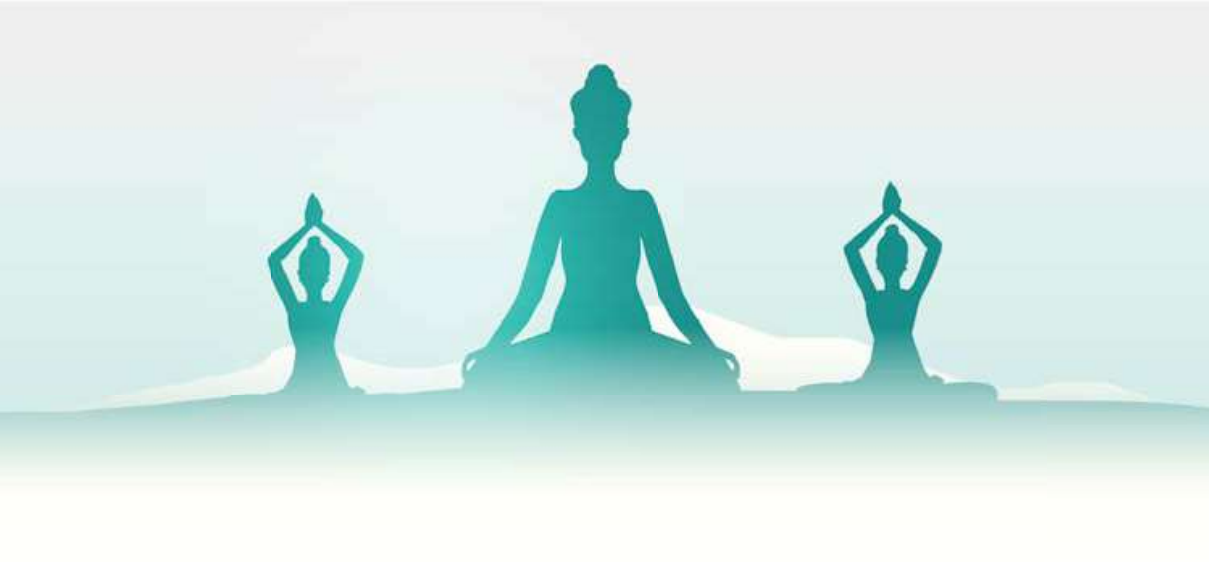Introduction
What began in the early 19th century as a curiosity about Hindu thought system through translated works and visitors from the West, today stands as the most widely adopted complementary health practice in the United States.
The statistics related to the Yoga industry are undeniably impressive. In the United States, approximately 36 million Americans practice Yoga, and between 2012 and 2016, this figure witnessed a remarkable 50% growth. During the same period, the number of male Yoga practitioners surged from four million to ten million. It is noteworthy that every third American has, at the very least, experimented with Yoga, and in 2017, more than a third of Americans favored Yoga and meditation as Complementary and Alternative Medicine (CAM). A recent report by The Wall Street Journal even highlighted instances of overcrowded Yoga classes leading to disputes among practitioners due to limited space.
On the flip side, there has been a burgeoning growth in America’s Yoga instructors. Presently, over 100,000 Americans have obtained qualifications as Yoga teachers, and more than 6,000 Yoga studios have opened their doors to enthusiastic Yoga enthusiasts. The global Yoga industry is estimated to yield an annual economic impact of $80 billion, with a substantial $16 billion directed toward Yoga classes, equipment, clothing, and accessories in the United States alone.
The intriguing journey of this Hindu spiritual practice to the United States, spanning approximately two centuries, can be segmented into two partially overlapping phases. The initial phase witnessed the introduction of Hindu thought into America, conveyed by visiting gurus, swamis, and yogis from India as an integrated system for spiritual self-discovery. Subsequently, the second phase experienced the gradual assimilation and Westernization of these ideas, along with their widespread commercialization, resulting in the emergence of diverse offshoot traditions with a primary emphasis on health benefits and a diminishing connection to its spiritual roots.
Introduction of Yoga to Western World
Following his historic address at the Parliament of Religions in 1893, Swami Vivekananda embarked on a two-year journey of lecturing throughout the eastern and central regions of the United States. His erudite discourses on Yoga and Vedanta captivated large audiences wherever he went. Indeed, it is difficult to find a more concise and clearer exposition of the essence of Yoga and its links to Hindu thought, than Swami Vivekananda’s: “The Hindu focused on the inner world, delving into the unseen realms within the Self, and developed the science of Yoga. Yoga involves the mastery of the senses, will, and mind, and its study empowers us to exert control rather than being subject to it. The mind appears as layers upon layers, and our ultimate goal is to transcend these intervening strata within our being and attain realization of God. The ultimate purpose of Yoga is to experience God. To achieve this, we must surpass relative knowledge and transcend the sensory world. While the world is awake to the senses, the children of the Lord are awakened in a different realm – they are the true seekers of God. There is only one way to master the senses: to perceive the Reality that exists in the universe. Only then can we genuinely conquer our senses.”
Swami Vivekananda recognized Yoga’s contributions to health and physical fitness, yet he firmly centered his teachings on the spiritual core of this tradition. He delivered extensive discourses on various forms of Yoga, including Karma Yoga, Jnana Yoga, Bhakti Yoga, and Raj Yoga, each serving as a path toward moksha, the ultimate state of self-realization. Among these, Raja Yoga, commonly known as Yoga, stands as the most widely practiced form globally, often mistakenly equated with Asanas or physical postures. In reality, it represents an integrated system of mental and physical control practices, comprising eight limbs or Ashtanga. The comprehensive theory and practice of the Ashtanga Yoga system are expounded in Patañjali’s Yogasutra, the foremost authoritative work on the subject. Although the exact compilation date remains uncertain, it is understood that Patanjali consolidated and organized knowledge from much older traditions. Many artifacts discovered from the Sindhu Saraswati Civilization, dating back to 3000 BCE, illustrate the most ancient depictions of Yoga postures known to humanity.
Transmission and Absorption
A few decades later, Swami Vivekananda was succeeded by Paramahansa Yogananda (1893-1952), who made history as the first Hindu Vedanta and Yoga teacher to settle in the United States. He became the first prominent Indian to be hosted at the White House by President Calvin Coolidge in 1927. His early acclaim earned him the title of “the 20th century’s first superstar guru,” as dubbed by the Los Angeles Times.
By 1930, Paramahansa Yogananda had founded twelve Yogoda-Satsang centers throughout America. This movement persists today in the form of two competing institutions: the Self Realization Fellowship and the Church of Self-Realization, the latter initiated by Swami Kriyananda, one of his disciples who branched out. In 1946, Paramahansa Yogananda authored the renowned “Autobiography of a Yogi,” widely regarded as a spiritual classic on Yoga. Through his Kriya Yoga teachings, he conveyed to America the idea that the body, mind, and soul could be made ‘healthier’ through dedicated practice and discipline.
Swami Vivekananda and Paramahansa Yogananda, in their unique ways, paved the path for traditional Yoga gurus to impart their wisdom to the Western world. Among them was a remarkable figure, often referred to as a ‘one-man Yoga university’ – Tirumalai Krishnamacharya (1888-1989), often called the ‘father of modern Yoga’ and the ‘grandfather of American Yoga.’ He is widely recognized as the architect of vinyasa karma Yoga, a discipline uniting breath control with graceful bodily movements. His everlasting legacy is the numerous accomplished students he mentored, including Indra Devi, B.K.S. Iyengar, and Pattabhi Jois. Their mastery of Yoga was so comprehensive that they collectively earned the reputation of being the ‘technicians’ of asana practice.
Eugenie Peterson (1899-2002), better known as Indra Devi and hailed as the ‘first lady of Yoga,’ was the initial non-Indian and female student of Krishnamacharya. Devi introduced her unique form of Yoga, focusing on body postures (asanas) and breathing techniques (pranayama), without incorporating spiritual elements. Her teachings spanned across India, China, and America. In 1948, she established her Yoga studio in Hollywood, becoming the first of its kind in Los Angeles. Indra Devi played a pivotal role in popularizing Yoga as a means for health, fitness, and youthful vitality, particularly among American women. Her studio effectively transformed Yoga from a spiritual pursuit into a trendy fitness regimen and stress-relief practice. Notably, her celebrity students included prominent Hollywood figures like Greta Garbo, Eva Gabor, Gloria Swanson, Ramon Navarro, Robert Ryan, Yule Brynner, Jennifer Jones, and the renowned violinist Yehudi Menuhin, who later introduced the eminent B.K.S. Iyengar to the Western world. Indra Devi authored several books on Yoga and health, such as “Yoga for You,” “Yoga for Americans,” “Forever Young, Forever Healthy,” and “Renew Your Life Through Yoga.”
According to her biographer, Michelle Goldberg, Indra Devi’s lifelong aspiration was to bring Yoga to the Western world. In the 1990s, when Yoga became an integral part of cosmopolitan urban culture, signifying a lifestyle that was both wholesome and attractive, she had undoubtedly succeeded in her mission. Despite the more strenuous style of Yoga that emerged, Yoga remained, as Goldberg notes, primarily a female pursuit, just as Indra Devi had shaped it. She also established the association between Yoga and organic food, holistic spas, and biodynamic beauty products in the Western consciousness.
BKS Iyengar (1918-2014), one of T. Krishnamacharya’s distinguished disciples and the creator of “Iyengar Yoga,” was a globally acclaimed Yoga teacher. Iyengar Yoga represented his interpretation of Hatha Yoga, which he learned from his guru. He gained international recognition for instructing Yoga to numerous celebrities, including philosopher Jiddu Krishnamurti, Queen Elisabeth of Belgium, author Aldous Huxley, actress Annette Benning, filmmaker Mira Nair, and designer Donna Karan.
In 1966, he authored his first book, “Light of Yoga,” which became an international best-seller. This book emphasized the crucial importance of absolute precision when practicing asanas and delved into the philosophy and practices that make Yoga a perfect path for spiritual growth. “Light of Yoga” was followed by 13 other books that covered various aspects of pranayama and Yoga philosophy. In 2004, Time Magazine recognized Iyengar as one of the 100 most influential people globally, and in 2011, he was honored with a commemorative stamp by China Post. By that time, there were over thirty thousand Iyengar Yoga students in 57 cities in China.
Pattabhi Jois (1915-2009), the third member of this triumvirate, was an advocate of Ashtanga Vinyasa Yoga, which combined fluid movements with synchronized breath. In 1974, he made his first journey to the West to speak at an international Yoga conference, followed by a four-month stay in California, marking the inception of Ashtanga Vinyasa Yoga in America. It swiftly gained popularity as a preferred pursuit for both spiritual and fitness goals.
T.K.V. Desikachar (1938-2016), another disciple of Krishnamacharya, happened to be his son. Initially uninterested in Yoga as a child, Desikachar rediscovered his passion for it in his early 20s and developed a deep connection to the practice. He traveled extensively to teach his version of Yoga, which he initially called Viniyaga but later abandoned the term. He first lectured in the United States in 1976 and later made regular visits to teach and lecture on his approach to Yoga and yogic healing. He also authored several books on the subject, including “Health, Healing, and Beyond,” “The Viniyoga of Yoga,” and “The Heart of Yoga.”
The exponential growth in Yoga’s popularity did not escape the notice of mass merchandisers. Yoga studios began to proliferate, catering to the burgeoning trend that was increasingly marketed for its physical and mental health benefits. Walt Baptiste (1917-2001) and Magana Baptiste (1921-2016), both students of Paramahansa Yogananda, opened their first Yoga studio in San Francisco in 1955. Over the following decades, the Baptiste Studio and the Baptiste Institute emerged, educating over a million students and preparing over a thousand teachers to promote the message of Baptiste Power Yoga. With the increasing commodification of Yoga, it began to evolve as a system focused on asanas or body postures, often detached from its spiritual origins.
While Yoga was considered a serious endeavor, Swami Vishnudevananda (1927-1993) introduced an innovative concept to enhance its mass appeal by making it feel like a holiday. Known as the ‘Flying Swami’ in the West due to his peace flights over troubled areas, he is credited with conceptualizing “Yoga Vacation.” Beginning in the late 1950s, he established a network of Sivananda Yoga Vedanta Centers, named after his guru Swami Sivananda Saraswati. These centers provided people with places to experience complete relaxation of body, mind, and spirit. He also authored “The Complete Illustrated Book of Yoga,” a creation that guided millions on their Yoga journeys. Swami Vishnudevananda also popularized the concept of “Yoga of Synthesis,” which involved integrating the four principal paths forming the foundations of Yoga – Karma Yoga, Bhakti Yoga, Jnana Yoga, and Rāja Yoga.
By the early 1960s, television became a potent medium for spreading Yoga in America, thanks to Richard Hittleman (1927-1991), who taught Yoga to millions through his show “Yoga for Health,” broadcast during the 1960s and 1970s. Hittleman is credited with introducing Yoga to literally millions of people via television. As a student of Ramana Maharishi, he also authored a series of books on Yoga, covering a range of topics influenced by Yoga, including fitness, personal living, beauty, and diet.
Maharishi Mahesh Yogi (1918-2008) is renowned for introducing the Western world to Transcendental Meditation (TM), a technique he developed to attain a state of enlightenment through inner tranquility. While his primary focus was on meditation, he also encouraged the practice of asanas and pranayama before meditation. In the late 1960s, he gained immense fame as the guru to the Beatles, Beach Boys, and other celebrities. Initially framed as a spiritual practice, under Maharishi’s guidance, TM and Yoga evolved into evidence-based scientific methodologies, making them more appealing to a broader Western audience. Over his lifetime, Maharishi is credited with teaching his techniques to more than five million people worldwide and establishing thousands of teaching centers.
Swami Muktananda (1908 – 1982) is a notable figure in this journey. After years of searching for spiritual fulfillment, he received a profound and sublime shaktipat initiation from Bhagvan Nityananda in 1947. Nine years later, he established Siddha Yoga, a discipline that incorporated teachings from Vedanta and Kashmir Shaivism. Between 1970 and 1981, Muktananda embarked on three worldwide tours, establishing ashrams and meditation centers in various countries, including the Siddha Yoga Ashram in Oakland, California, and the Shree Muktanada Ashram in the Catskills Mountains, northwest of New York City. Muktananda authored several books on topics such as Kundalini Shakti, Vedanta, and Kashmir Shaivism, including his spiritual autobiography, “The Play of Consciousness.”
Sylvia Hellman, a Canadian born in Berlin in 1911, experienced numerous hardships in her life. In 1955, she travelled to India to meet Swami Sivananda Saraswati with hopes of self-discovery. After just a two-month stay in India, her guru gave her a significant mission: “Start an ashram or school [in Canada] for the divine teachings of Yoga and Vedanta.” She returned to Canada, adopted the name Swami Sivananda Radha (1911-1995), and began teaching Yoga classes, lecturing on Yoga philosophy, and sharing her Indian experiences on television. In 1963, she founded the first Canadian ashram on the West Coast, where she tailored her teachings to Westerners. She developed a gentler and more meditative style of practice, which she called Hidden Language Hatha Yoga. Swami Radha aimed to bring quality into her students’ lives, believing that true spirituality required this quality, even if one meditated for six hours a day. She wrote dozens of books, launched a quarterly journal that would later become the international Yoga magazine Ascent, and opened several urban Yoga centers.
Lilias Folin (born in 1936), affectionately known as the “Julia Child of Yoga,” became a household name in the 1970s for introducing Yoga into American living rooms through her PBS series “Lilias, Yoga and You.” She followed up with “Lilias! Yoga Gets Better with Age” in the late 1980s and early ’90s. While her show reached millions, Lilias had a unique ability to connect with people, making her viewers feel as though she was a friend and confidante. In a 1974 Time magazine article on the growing interest in Yoga, she was likened to the beloved cookbook author and TV personality Julia Child, and the moniker stuck.
In the early 1970s, Swami Rama (1925-1996) garnered worldwide attention, not only as a spiritual guru but also as a subject of research when he demonstrated complete control over his body, altering his pulse rate, temperature, and heart rate at will. Swami Rama’s enduring contribution to Yoga in America was the establishment of the “Himalayan International Institute of Yoga Science and Philosophy” in Chicago in 1971, along with his book “Living with the Himalayan Masters” (1978).
Swami Satchidananda (1914–2002), another disciple of Swami Sivananda Saraswati, arrived in America during the height of the counter-culture movement in the 1960s. He gained instant fame by delivering the opening address at the Woodstock Festival in 1969. Over his lifetime, he travelled over two million miles worldwide to popularize his trademarked version of Yoga, called Integral Yoga. This system was described as “a flexible combination of specific methods to develop every aspect of the individual: physical, intellectual, and spiritual.” In 1969, he initiated the Integral Yoga Magazine, which remains an eWeekly magazine to this day. Swami Satchidananda’s objective of promoting ‘an easeful body, a peaceful mind, and a useful life’ is being carried forward by his Integral Yoga Institute, established in 1966, which now has over 30 branches across six continents.
By this time, it was evident that Yoga had secured its place in the West and was seen as a lucrative business. As a result, various institutions and organizations were being formed. The Yoga Society of Pennsylvania and the Kripalu Yoga Ashram were both established by Amrit Desai, the guru credited with developing a new Yoga system he named Kripalu Yoga, in honor of his guru Swami Kripalvananda. The ashram later changed its name to the Kripalu Yoga Fellowship and was eventually rebranded as the Kripalu Center for Yoga & Health in 1983. In 1978, Baba Hari Dass founded the Mount Madonna Center to offer a wide range of residential Yoga programs. Subsequently, the Pacific Cultural Center in Santa Cruz and the Salt Spring Yoga Center were established to disseminate his teachings. In 1989, the International Association of Yoga Therapists (IAYT) was founded by two veteran Yoga teachers, Larry Payne and Richard Miller. The IAYT aimed to support research and education in Yoga and serve as a training platform for Yoga teachers and therapists. Today, numerous ashrams and institutions, built on the works of Swamis Muktananda, Vishnudevananda, Srila Prabhupada, and contemporary gurus like Mata Amritanandamayi, Sri Karunamayi, Sri Sri Ravi Shankar, and Sadhguru Jaggi Vasudev, can be found throughout the United States and around the world.



![[Deccan Herald] TTD chief seeks suggestions from Hindu pontiffs at conclave](https://hinduvishwa.org/wp-content/uploads/2024/02/Ambassadors-and-diplomats-from-42-countries-visit-Abu-Dhabis-BAPS-Hindu-Mandir-75x75.jpg)
![[ India Today ] Ohio senator JD Vance thanks wife, a Hindu, for helping him find Christian faith](https://hinduvishwa.org/wp-content/uploads/2024/06/us-senator-jd-vance-reveals-how-his-hindu-wife-usha-helped-him-find-his-christian-faith-image-re-272530504-16x9_0-120x86.webp)










